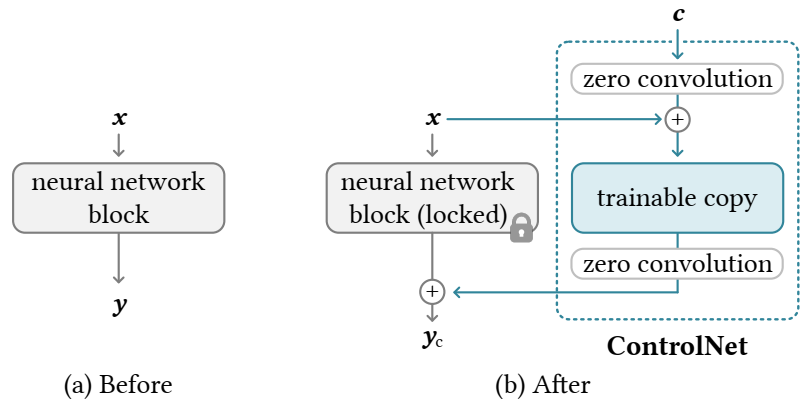原文:Adding Conditional Control to Text-to-Image Diffusion Models
1 简介
- 出发点:文本提示单独精确表达复杂的布局、姿势、形状和形式可能是困难的。希望让用户提供额外的图像来实现更细粒度的空间控制,这些图像直接指定其期望的图像构图。
ControlNet: 端到端神经网络架构,用于学习大型训练文本到图像扩散模型的条件控制。
- 锁定扩散模型的参数来保持大模型的质量和能力
- 制作了一个可训练副本来处理其编码层
- 把预训练模型视为学习多样化条件控制的主干
- 可训练副本与原始锁定模型通过零卷积层连接,其权重初始化为零,并在训练过程中逐渐增长。
2 方法
2.1 ControlNet
ControlNet 将额外条件注入到神经网络的块中。

方法:锁定 原始块 并创建一个可训练的副本,并通过零卷积层连接它们,即,1×1卷积,权重和偏差均初始化为零。这里 c 是添加到网络中的条件向量。
假设 $\mathcal F(\cdot; \Theta)$ 是一个经过训练的神经块(一组通常组合在一起形成神经网络单元的神经层),参数为 $\Theta$ 。
将输入特征图 $x$ 转换为另一个特征图 $y$ :$y = \mathcal F(x; \Theta)$
在我们的设置中,$x$ 和 $y$ 通常是二维特征图,$x, y\in \mathbb R^{h\times w\times c}$
- 为了将 ControlNet 加入到这样的预训练神经块中,我们锁定(冻结)原始块的参数 $\Theta$ ,同时 复制该块 为一个 可训练副本,具有参数 $\Theta_c$ 。可训练副本将外部条件 $c$ 作为输入。
- 可训练副本 通过 零卷积层 与 锁定模型 相连,记作 $\mathcal Z(\cdot; \cdot)$。具体而言,$\mathcal Z(\cdot; \cdot)$ 是一个 1×1 的卷积层,其权重和偏置均初始化为零。为了建立 ControlNet,分别使用两个参数为 $\Theta_{z1}$ 和 $\Theta_{z2}$ 的零卷积实例。
完整的 ControlNet 计算:
$$ y_c = \mathcal F(x;\Theta) + \mathcal Z(\mathcal F(x + \mathcal Z(c;\Theta_{z1});\Theta_{c});\Theta_{z2}) $$
- 第一个训练步骤中,由于零卷积层的权重和偏置参数都初始化为零,上面方程的两个 $\mathcal Z(\cdot; \cdot)$ 两项均评估为零,并且 $y_c = y$ 。这种情况下,有害噪声无法影响可训练副本中神经网络层的隐藏状态。
- 此外,由于 $Z(c;\Theta_{z1}) = 0$ 而可训练副本也接收输入图像 $x$,因此可训练副本完全功能化并保留大型预训练模型的能力,使其能够作为进一步学习的强大骨干。
2.2 ControlNet for Text-to-Image Diffusion
Stable Diffusion 的结构:编码器 + 中间块 + 解码器
- 编码器 和 解码器 都包含 12 个块
- 完整模型包含 25 个块,其中 8 个块是下采样或上采样的卷积层,其余 17 块为主块,每个主块包含 4 个 ResNet 层 和 2 个 Vision Transformers (ViTs),每个 ViT 包含多个 cross-attention 和 self-attention 机制。
- Text prompts 使用 CLIP 文本编码器,扩散时间步长通过位置编码通过 time encoder 编码。

- ControlNet 结构应用于 U-Net 的每个Encoder Block。
- 使用 ControlNet 创建 Stable Diffusion 的 12 个 Encoder Block 和 1 个 Middle Block 的可训练副本。输出添加到 U-Net 的 12 个 skip-connection 和 1 个 middle block 上。
为了将 ControlNet 添加到 Stable Diffusion 中,我们首先将每个输入条件图像从输入大小 512 × 512 像素空间图像转换为与 Stable Diffusion 大小匹配的 64×64 特征空间向量。特别地,我们使用一个包含四个卷积层的微小网络 $\mathcal E(\cdot)$ ,将图像空间条件 $c_i$ 编码为特征空间向量 $c_f$,如:
$$ c_f = \mathcal E(c_i) $$
将条件向量 $c_f$ 传入 ControlNet
3 Training
给定输入图像 $z_0$ ,图像扩散算法逐步向图像增加噪声,并产生噪声图像 $z_t$,其中 $t$ 表示添加噪声的次数。基于一组条件,包括时间步 $\boldsymbol{t}$、文本提示 $\boldsymbol{c}_t$ 以及 特定任务的条件 $\boldsymbol{c}_f$ ,图像扩散算法学习一个网络 $\epsilon_\theta$ 来预测添加到 $\boldsymbol{z}_t$ 中的噪声。Diffusion Model 的总体学习目标:
$$ \mathcal L = \mathbb E_{\boldsymbol{z}_0, \boldsymbol{t}, \boldsymbol{c}_t, \boldsymbol{c}_f\sim \mathcal N(0,1)}\left[\|\epsilon - \epsilon_\theta(\boldsymbol{z}_t, \boldsymbol{t}, \boldsymbol{c}_t, \boldsymbol{c}_f)\|_2^2 \right] $$
模型不是逐渐学习控制条件,而是突然成功地跟随输入的条件图像(sudden convergence phenomenon)
4 Inference
无分类器引导分辨率加权:Stable Diffusion 依赖于 无分类器引导(Classifier-Free Guidance, CFG) 的技术生成高质量图像。
CFG 的公式:$\epsilon_{\text{prd}} = \epsilon_{\text{uc}} + \beta_{\text{cfg}}(\epsilon_{\text{c}} - \epsilon_{\text{uc}})$
- $\epsilon_{\text{prd}}$:模型的最终输出
- $\epsilon_{\text{uc}}$:模型的无条件输出
- $\epsilon_{\text{c}}$:模型的有条件输出
- $\beta_{\text{cfg}}$:用户指定的权重
通过 ControlNet 添加条件图像时,可以将其添加到 $\epsilon_{\text{uc}}$ 和 $\epsilon_{\text{c}}$ ,或者仅添加到 $\epsilon_{\text{c}}$ 。仅使用 $\epsilon_{\text{c}}$ 将使引导非常强。
组合多个 ControlNets: 为了将多个条件图像应用到一个 Stable Diffusion 的实例,可以直接将相应的 ControlNets 的输出添加到 Stable Diffusion 模型中。(不需要额外的加权或线性插值)
5 代码
源码:https://github.com/lllyasviel/ControlNet/tree/main
ControlledUnetModel:
class ControlledUnetModel(UNetModel):
def forward(self, x, timesteps=None, context=None, control=None, only_mid_control=False, **kwargs):
hs = []
with torch.no_grad():
t_emb = timestep_embedding(timesteps, self.model_channels, repeat_only=False)
emb = self.time_embed(t_emb)
h = x.type(self.dtype)
for module in self.input_blocks:
h = module(h, emb, context)
hs.append(h)
h = self.middle_block(h, emb, context)
# 如果提供了 control信号,将它应用到当前的特征图中
if control is not None:
h += control.pop()
for i, module in enumerate(self.output_blocks):
if only_mid_control or control is None:
h = torch.cat([h, hs.pop()], dim=1)
else: # 将 control信号添加当前输出特征图中
h = torch.cat([h, hs.pop() + control.pop()], dim=1)
h = module(h, emb, context)
h = h.type(x.dtype)
return self.out(h)ControlNet:
class ControlNet(nn.Module):
def __init__(
self,
...,
hint_channels,
...,
):
super().__init__()
# ... 特殊情况判断(省略)
self.dims = dims
self.image_size = image_size
self.in_channels = in_channels
self.model_channels = model_channels
if isinstance(num_res_blocks, int):
self.num_res_blocks = len(channel_mult) * [num_res_blocks]
else:
if len(num_res_blocks) != len(channel_mult):
...
self.num_res_blocks = num_res_blocks
if disable_self_attentions is not None:
# should be a list of booleans, indicating whether to disable self-attention in TransformerBlocks or not
assert len(disable_self_attentions) == len(channel_mult)
if num_attention_blocks is not None:
...
self.XXX = XXX
# ...省略
self.predict_codebook_ids = n_embed is not None
time_embed_dim = model_channels * 4
self.time_embed = nn.Sequential(
linear(model_channels, time_embed_dim),
nn.SiLU(),
linear(time_embed_dim, time_embed_dim),
)
self.input_blocks = nn.ModuleList(
[
TimestepEmbedSequential(
conv_nd(dims, in_channels, model_channels, 3, padding=1)
)
]
)
# 零卷积层
self.zero_convs = nn.ModuleList([self.make_zero_conv(model_channels)])
# 条件特征图处理
self.input_hint_block = TimestepEmbedSequential(
conv_nd(dims, hint_channels, 16, 3, padding=1),
nn.SiLU(),
conv_nd(dims, 16, 16, 3, padding=1),
nn.SiLU(),
conv_nd(dims, 16, 32, 3, padding=1, stride=2),
nn.SiLU(),
conv_nd(dims, 32, 32, 3, padding=1),
nn.SiLU(),
conv_nd(dims, 32, 96, 3, padding=1, stride=2),
nn.SiLU(),
conv_nd(dims, 96, 96, 3, padding=1),
nn.SiLU(),
conv_nd(dims, 96, 256, 3, padding=1, stride=2),
nn.SiLU(),
zero_module(conv_nd(dims, 256, model_channels, 3, padding=1)) # 零卷积层
)
self._feature_size = model_channels
input_block_chans = [model_channels]
ch = model_channels
ds = 1
# 根据每一层的channel_mult和num_res_blocks构建多层
for level, mult in enumerate(channel_mult):
for nr in range(self.num_res_blocks[level]):
layers = [
ResBlock(
ch,
time_embed_dim,
dropout,
out_channels=mult * model_channels,
dims=dims,
use_checkpoint=use_checkpoint,
use_scale_shift_norm=use_scale_shift_norm,
)
]
ch = mult * model_channels
# 如果当前分辨率需要使用注意力块,添加注意力层
if ds in attention_resolutions:
if num_head_channels == -1:
dim_head = ch // num_heads
else:
num_heads = ch // num_head_channels
dim_head = num_head_channels
if legacy:
# num_heads = 1
dim_head = ch // num_heads if use_spatial_transformer else num_head_channels
if exists(disable_self_attentions):
disabled_sa = disable_self_attentions[level]
else:
disabled_sa = False
if not exists(num_attention_blocks) or nr < num_attention_blocks[level]:
layers.append(
AttentionBlock(
ch,
use_checkpoint=use_checkpoint,
num_heads=num_heads,
num_head_channels=dim_head,
use_new_attention_order=use_new_attention_order,
) if not use_spatial_transformer else SpatialTransformer(
ch, num_heads, dim_head, depth=transformer_depth, context_dim=context_dim,
disable_self_attn=disabled_sa, use_linear=use_linear_in_transformer,
use_checkpoint=use_checkpoint
)
)
self.input_blocks.append(TimestepEmbedSequential(*layers))
self.zero_convs.append(self.make_zero_conv(ch))
self._feature_size += ch
input_block_chans.append(ch)
# 处理下采样
if level != len(channel_mult) - 1:
out_ch = ch
self.input_blocks.append(
TimestepEmbedSequential(
ResBlock(
ch,
time_embed_dim,
dropout,
out_channels=out_ch,
dims=dims,
use_checkpoint=use_checkpoint,
use_scale_shift_norm=use_scale_shift_norm,
down=True,
)
if resblock_updown
else Downsample(
ch, conv_resample, dims=dims, out_channels=out_ch
)
)
)
ch = out_ch
input_block_chans.append(ch)
self.zero_convs.append(self.make_zero_conv(ch))
ds *= 2
self._feature_size += ch
# 配置最后的中间块(包括自注意力块)
if num_head_channels == -1:
dim_head = ch // num_heads
else:
num_heads = ch // num_head_channels
dim_head = num_head_channels
if legacy:
# num_heads = 1
dim_head = ch // num_heads if use_spatial_transformer else num_head_channels
self.middle_block = TimestepEmbedSequential(
ResBlock(
...,
),
AttentionBlock(
...,
) if not use_spatial_transformer else SpatialTransformer( # always uses a self-attn
...,
),
ResBlock(
...,
),
)
self.middle_block_out = self.make_zero_conv(ch)
self._feature_size += ch
def make_zero_conv(self, channels): # 零卷积函数
return TimestepEmbedSequential(zero_module(conv_nd(self.dims, channels, channels, 1, padding=0)))
# 前向传播函数
def forward(self, x, hint, timesteps, context, **kwargs):
t_emb = timestep_embedding(timesteps, self.model_channels, repeat_only=False)
emb = self.time_embed(t_emb)
# 处理 条件输入
guided_hint = self.input_hint_block(hint, emb, context)
outs = []
h = x.type(self.dtype)
# 逐层处理输入数据
for module, zero_conv in zip(self.input_blocks, self.zero_convs):
if guided_hint is not None:
h = module(h, emb, context)
h += guided_hint
guided_hint = None
else:
h = module(h, emb, context)
outs.append(zero_conv(h, emb, context))
# 处理中间块
h = self.middle_block(h, emb, context)
outs.append(self.middle_block_out(h, emb, context))
return outs